TiO2 Nanotubes on Ti Dental Implant. Part 3: Electrochemical Behavior in Hank’s Solution of Titania Nanotubes Formed in Ethylene Glycol
Abstract
1. Introduction
2. Materials and Methods
TiO2 Nanotube Film Preparation
3. Results and Discussion
3.1. Morphological Analysis
3.2. XRD Analysis
3.3. Electrochemical Analysis
4. Conclusions
Author Contributions
Funding
Conflicts of Interest
References
- Brunette, P.T.D.M.; Textor, M.; Thomsen, P. Titanium in Medicine; Springer: Berlin/Heidelberg, Germany, 2001. [Google Scholar]
- Long, M.; Rack, H.J. Titanium alloys in total joint replacement—A materials science perspective. Biomaterials 1998, 19, 1621–1639. [Google Scholar] [CrossRef]
- Monetta, T.; Acquesta, A.; Bellucci, F. Evaluation of roughness and electrochemical behavior of titanium in biological environment. Metall. Ital. 2014, 106, 13–21. [Google Scholar]
- Yang, B.; Uchida, M.; Kim, H.-M.; Zhang, X.; Kokubo, T. Preparation of bioactive titanium metal via anodic oxidation treatment. Biomaterials 2004, 25, 1003–1010. [Google Scholar] [CrossRef]
- Monetta, T.; Scala, A.; Malmo, C.; Bellucci, F. Antibacterial Activity of Cold Plasma & minus—Treated Titanium Alloy. Plasma Med. 2011, 1, 205–214. [Google Scholar]
- Monetta, T.; Bellucci, F. Strong and Durable Antibacterial Effect of Titanium Treated in Rf Oxygen Plasma: Preliminary Results. Plasma Chem. Plasma Process. 2014, 34, 1247–1256. [Google Scholar] [CrossRef]
- Roy, P.; Berger, S.; Schmuki, P. TiO2 Nanotubes: Synthesis and Applications. Angew. Chem. Int. Ed. 2011, 50, 2904–2939. [Google Scholar] [CrossRef] [PubMed]
- Wang, J.; Fan, H.; Zhang, H.; Chen, Q.; Liu, Y.; Ma, W. Anodizing process of titanium and formation mechanism of anodic TiO2 nanotubes. Prog. Chem. 2016, 28, 284–295. [Google Scholar]
- Xie, Z.B.; Blackwood, D.J. Effects of anodization parameters on the formation of titania nanotubes in ethylene glycol. Electrochim. Acta 2010, 56, 905–912. [Google Scholar] [CrossRef]
- Muti, M.N.; Dzilal, A.; Dennis, J. Effects of Synthesis Parameters on the structure of titania nanotubes. J. Eng. Sci. Technol. 2008, 3, 163–171. [Google Scholar]
- Bauer, S.; Kleber, S.; Schmuki, P. TiO2 nanotubes: Tailoring the geometry in H3PO4/HF electrolytes. Electrochem. Commun. 2006, 8, 1321–1325. [Google Scholar] [CrossRef]
- Omidvar, H.; Goodarzi, S.; Seif, A.; Azadmehr, A.R. Influence of anodization parameters on the morphology of TiO2 nanotube arrays. Superlattices Microstruct. 2011, 50, 26–39. [Google Scholar] [CrossRef]
- Yoriya, S.; Grimes, C.A. Self-assembled anodic TiO2 nanotube arrays: Electrolyte properties and their effect on resulting morphologies. J. Mater. Chem. 2011, 21, 102–108. [Google Scholar] [CrossRef]
- Lockman, Z.; Sreekantan, S.; Ismail, S.; Schmidt-Mende, L.; MacManus-Driscoll, J.L. Influence of anodisation voltage on the dimension of titania nanotubes. J. Alloys Compd. 2010, 503, 359–364. [Google Scholar] [CrossRef]
- Curtis, A.; Wilkinson, C.; Curtis, A.; Wilkinson, C. Nanotechniques and approaches in biotechnology. Mater. Today 2001, 4, 22–28. [Google Scholar] [CrossRef]
- Demetrescu, I.; Pirvu, C.; Mitran, V. Effect of nano-topographical features of Ti/TiO2 electrode surface on cell response and electrochemical stability in artificial saliva. Bioelectrochemistry 2010, 79, 122–129. [Google Scholar] [CrossRef] [PubMed]
- Hilario, F.; Roche, V.; Nogueira, R.P.; Junior, A.M.J. Influence of morphology and crystalline structure of TiO2 nanotubes on their electrochemical properties and apatite-forming ability. Electrochim. Acta 2017, 245, 337–349. [Google Scholar] [CrossRef]
- Yu, B.; Song, P.I.; Ho, P.H.; Ho, L.M.; Sung, B.T.; Warwick, D.; Michael, S. The effect of annealing temperatures on surface properties, hydroxyapatite growth and cell behaviors of TiO2 nanotubes. Surf. Interface Anal. 2011, 43, 998–1005. [Google Scholar]
- Kakoli, D.; Susmita, B.; Amit, B. TiO2 nanotubes on Ti: Influence of nanoscale morphology on bone cell–materials interaction. J. Biomed. Mater. Res. Part A 2009, 90, 225–237. [Google Scholar]
- Oh, S.; Daraio, C.; Chen, L.H.; Pisanic, T.R.; Fiñones, R.R.; Jin, S. Significantly accelerated osteoblast cell growth on aligned TiO2 nanotubes. J. Biomed. Mater. Res. Part A 2006, 78, 97–103. [Google Scholar] [CrossRef] [PubMed]
- Hsu, H.-C.; Wu, S.-C.; Hsu, S.-K.; Chang, Y.-C.; Ho, W.-F. Fabrication of nanotube arrays on commercially pure titanium and their apatite-forming ability in a simulated body fluid. Mater. Charact. 2015, 100, 170–177. [Google Scholar] [CrossRef]
- Tsuchiya, H.; Macak, J.M.; Muller, L.; Kunze, J.; Muller, F.; Greil, P.; Virtanen, S.; Schmuki, P. Hydroxyapatite growth on anodic TiO2 nanotubes. J. Biomed. Mater. Res. Part A 2006, 77, 534–541. [Google Scholar] [CrossRef] [PubMed]
- De Santo, I.; Sanguigno, L.; Causa, F.; Monetta, T.; Netti, P.A. Exploring doxorubicin localization in eluting TiO2 nanotube arrays through fluorescence correlation spectroscopy analysis. Analyst 2012, 137, 5076–5081. [Google Scholar] [CrossRef] [PubMed]
- Shidfar, S.; Tavangarian, F.; Nemati, N.H.; Fahami, A. Drug delivery behavior of titania nanotube arrays coated with chitosan polymer. Mater. Discov. 2017, 8, 9–17. [Google Scholar] [CrossRef]
- Khoshnood, N.; Zamanian, A.; Massoudi, A. Tailoring in vitro drug delivery properties of titania nanotubes functionalized with (3-Glycidoxypropyl) trimethoxysilane. Mater. Chem. Phys. 2017, 193, 290–297. [Google Scholar] [CrossRef]
- Padiyan, D.P.; Raja, D.H. Synthesis of Various Generations Titania Nanotube Arrays by Electrochemical Anodization for H2 Production. Energy Procedia 2012, 22, 88–100. [Google Scholar] [CrossRef]
- Monetta, T.; Acquesta, A.; Carangelo, A.; Bellucci, F. TiO2 Nanotubes on Ti Dental Implant. Part 1: Formation and Aging in Hank’s Solution. Metals 2017, 7, 167. [Google Scholar] [CrossRef]
- Monetta, T.; Acquesta, A.; Carangelo, A.; Bellucci, F. TiO2 nanotubes on Ti dental implant. Part 2: EIS characterization in Hank’s solution. Metals 2017, 7. [Google Scholar] [CrossRef]
- Mohan, L.; Anandan, C.; Rajendran, N. Electrochemical behaviour and bioactivity of self-organized TiO2 nanotube arrays on Ti-6Al-4V in Hanks’ solution for biomedical applications. Electrochim. Acta 2015, 155, 411–420. [Google Scholar] [CrossRef]
- Al-Mobarak, N.; Al-Swayih, A. Development of titanium surgery implants for improving osseointegration through formation of a titanium nanotube layer. Int. J. Electrochem. Sci. 2014, 9, 32–45. [Google Scholar]
- Wen, C.S.; Chon, C.C.; Yuan, H.S. Monitoring the Effects of Growing Titania Nanotubes on Titanium Substrate by Electrochemical Impedance Spectroscopy Measurement. Jpn. J. Appl. Phys. 2009, 48, 035004. [Google Scholar]
- Chen, Q.; Thouas, G.A. Metallic implant biomaterials. Mater. Sci. Eng. R Rep. 2015, 87, 1–57. [Google Scholar] [CrossRef]
- Ya, J.; Li, A.; Liu, Z.; Lei, E.; Zhao, W.; Zhao, D.; Liu, C. Investigation of surface morphologies of TiO2 nanotube arrays by anodization in ethylene glycol electrolytes. J. Optoelectron. Adv. Mater. 2011, 13, 684–688. [Google Scholar]
- Hoon, L.J.; Jinsub, C. Titanium Oxide Nanowires Originating from Anodically Grown Nanotubes: The Bamboo-Splitting Model. Small 2007, 3, 1504–1507. [Google Scholar]
- Kim, D.; Ghicov, A.; Schmuki, P. TiO2 Nanotube arrays: Elimination of disordered top layers (“nanograss”) for improved photoconversion efficiency in dye-sensitized solar cells. Electrochem. Commun. 2008, 10, 1835–1838. [Google Scholar] [CrossRef]
- Li, H.; Cheng, J.W.; Shu, S.; Zhang, J.; Zheng, L.; Tsang, C.K.; Cheng, H.; Liang, F.; Lee, S.T.; Li, Y.Y. Selective removal of the outer shells of anodic TiO2 nanotubes. Small 2013, 9, 37–44. [Google Scholar] [CrossRef] [PubMed]
- Martin, J.; Hirsch, S.G.; Giri, A.; Griep, M.H.; Karna, S.P. One-Step Synthesis and Characterization of Highly-Ordered Titanium Dioxide Nanotubes. In Proceedings of the 2012 12th IEEE International Conference on Nanotechnology (IEEE-NANO), Birmingham, UK, 20–23 August 2012. [Google Scholar]
- Song, Y.-Y.; Lynch, R.; Kim, D.; Roy, P.; Schmuki, P. TiO2 Nanotubes: Efficient Suppression of Top Etching during Anodic Growth: Key to Improved High Aspect Ratio Geometries. Electrochem. Solid-State Lett. 2009, 12, C17–C20. [Google Scholar] [CrossRef]
- Kontos, A.G.; Kontos, A.I.; Tsoukleris, D.S.; Likodimos, V.; Kunze, J.; Schmuki, P.; Falaras, P. Photo-induced effects on self-organized TiO2 nanotube arrays: the influence of surface morphology. Nanotechnology 2009, 20, 045603. [Google Scholar] [CrossRef] [PubMed]
- Macak, J.M.; Tsuchiya, H.; Taveira, L.; Aldabergerova, S.; Schmuki, P. Smooth Anodic TiO2 Nanotubes. Angew. Chem. Int. Ed. 2005, 44, 7463–7465. [Google Scholar] [CrossRef] [PubMed]
- Hu, M.Z.; Lai, P.; Bhuiyan, M.S.; Tsouris, C.; Gu, B.; Paranthaman, M.P.; Gabitto, J.; Harrison, L. Synthesis and characterization of anodized titanium-oxide nanotube arrays. J. Mater. Sci. 2009, 44, 2820–2827. [Google Scholar] [CrossRef]
- Lee, K.; Mazare, A.; Schmuki, P. One-Dimensional Titanium Dioxide Nanomaterials: Nanotubes. Chem. Rev. 2014, 114, 9385–9454. [Google Scholar] [CrossRef] [PubMed]
- Gibran, K.; Ibadurrahman, M.; Slamet. Effect of electrolyte type on the morphology and crystallinity of TiO2 nanotubes from Ti-6Al-4V anodization. IOP Conf. Ser. Earth Environ. Sci. 2018, 105, 012038. [Google Scholar] [CrossRef]
- Chuang, L.-C.; Luo, C.-H.; Yang, S. The structure and mechanical properties of thick rutile–TiO2 films using different coating treatments. Appl. Surf. Sci. 2011, 258, 297–303. [Google Scholar] [CrossRef]
- Mohan, L.; Anandan, C.; Rajendran, N. Electrochemical behavior and effect of heat treatment on morphology, crystalline structure of self-organized TiO2 nanotube arrays on Ti-6Al-7Nb for biomedical applications. Mater. Sci. Eng. C Mater. Biol. Appl. 2015, 50, 394–401. [Google Scholar] [CrossRef] [PubMed]
- De Assis, S.L.; Wolynec, S.; Costa, I. Corrosion characterization of titanium alloys by electrochemical techniques. Electrochim. Acta 2006, 51, 1815–1819. [Google Scholar] [CrossRef]
- Yu, W.Q.; Qiu, J.; Xu, L.; Zhang, F.Q. Corrosion behaviors of TiO2 nanotube layers on titanium in Hank’s solution. Biomed. Mater. 2009, 4, 065012. [Google Scholar] [CrossRef] [PubMed]
- Al-Swayih, A. Electrochemical Characterization of Titanium Oxide Nanotubes Fabricated by Anodizing in Three Kinds of Electrolytes. Life Sci. J. 2014, 11, 52–59. [Google Scholar]
- Jüttner, K. Electrochemical impedance spectroscopy (EIS) of corrosion processes on inhomogeneous surfaces. Electrochim. Acta 1990, 35, 1501–1508. [Google Scholar] [CrossRef]
- Simi, V.S.; Rajendran, N. Influence of tunable diameter on the electrochemical behavior and antibacterial activity of titania nanotube arrays for biomedical applications. Mater. Charact. 2017, 129, 67–79. [Google Scholar] [CrossRef]
- Martin, N.; Rousselot, C.; Rondot, D.; Palmino, F.; Mercier, R. Microstructure modification of amorphous titanium oxide thin films during annealing treatment. Thin Solid Films 1997, 300, 113–121. [Google Scholar] [CrossRef]
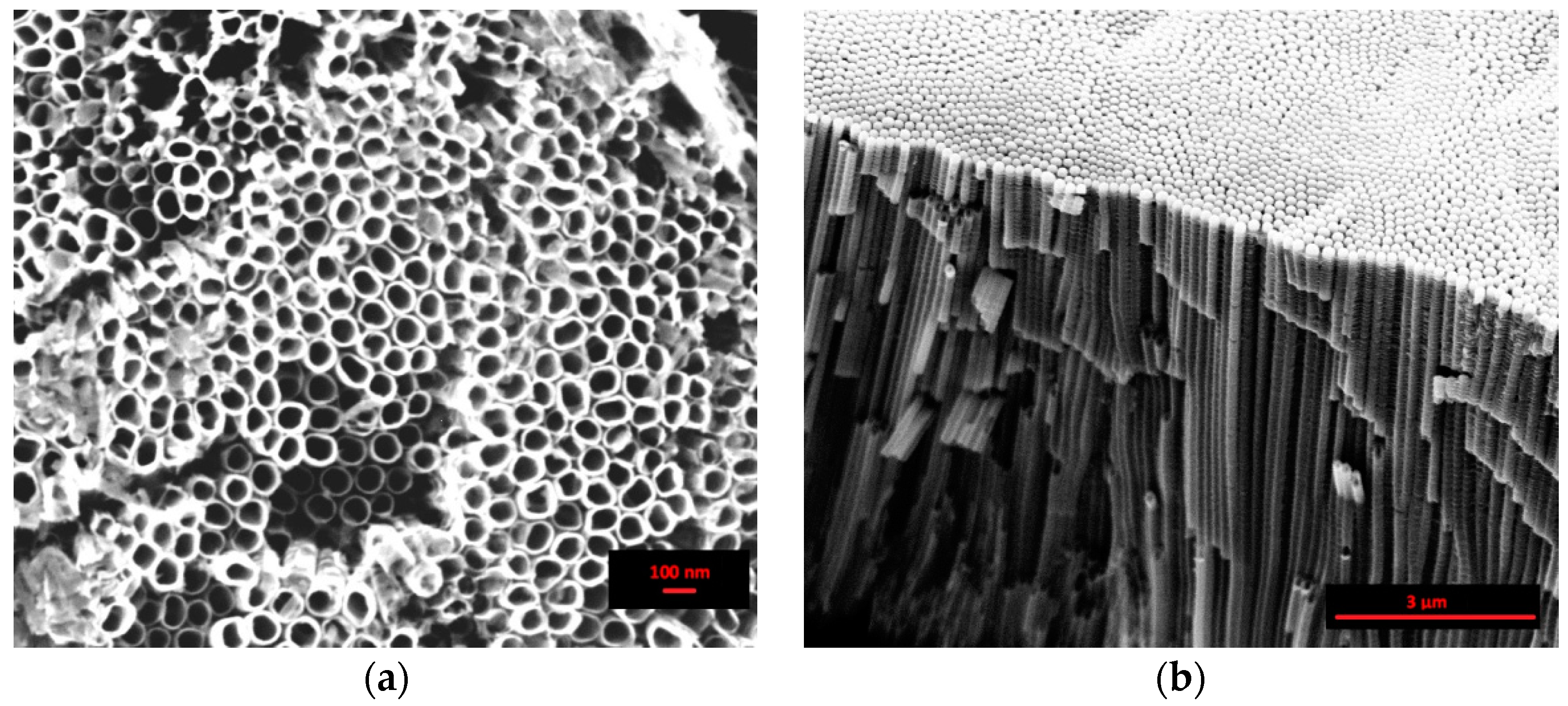
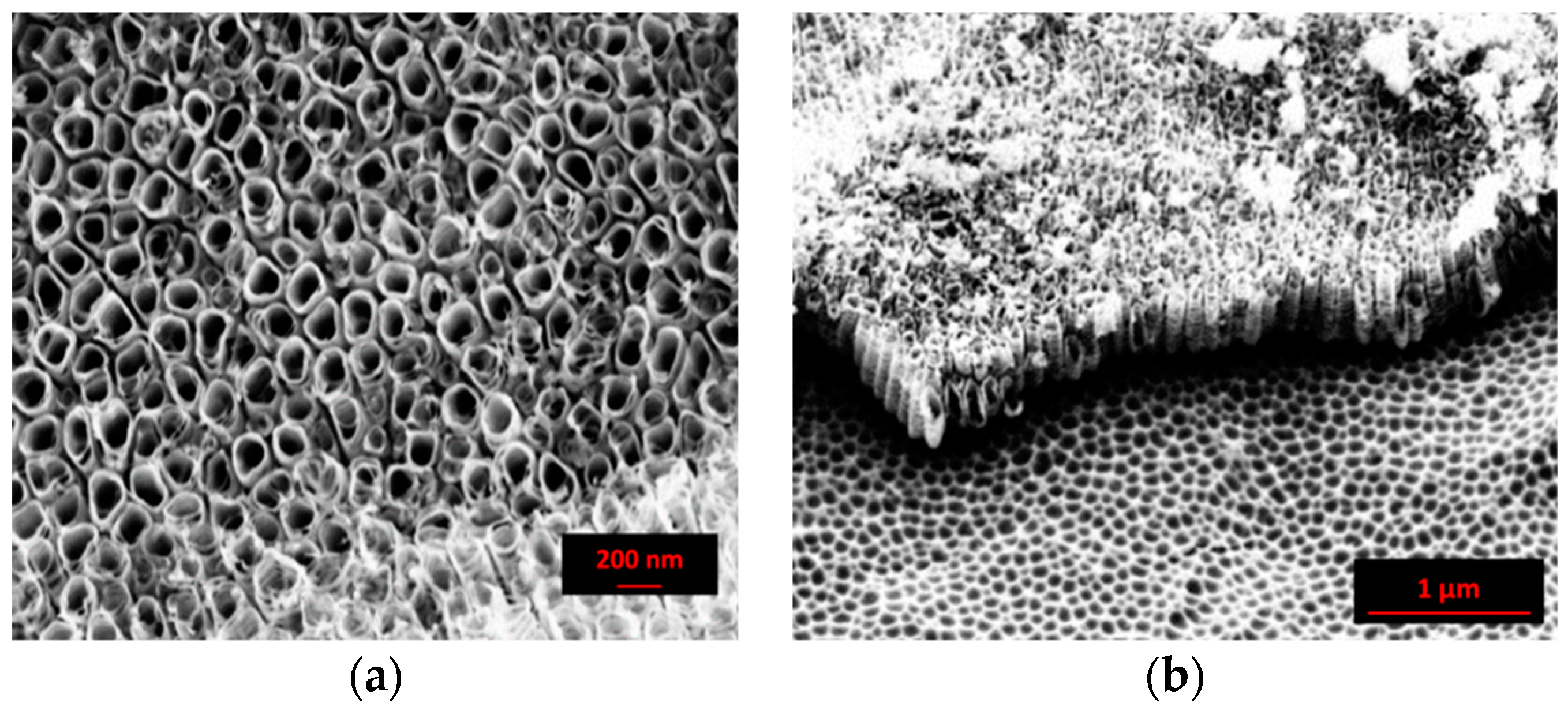
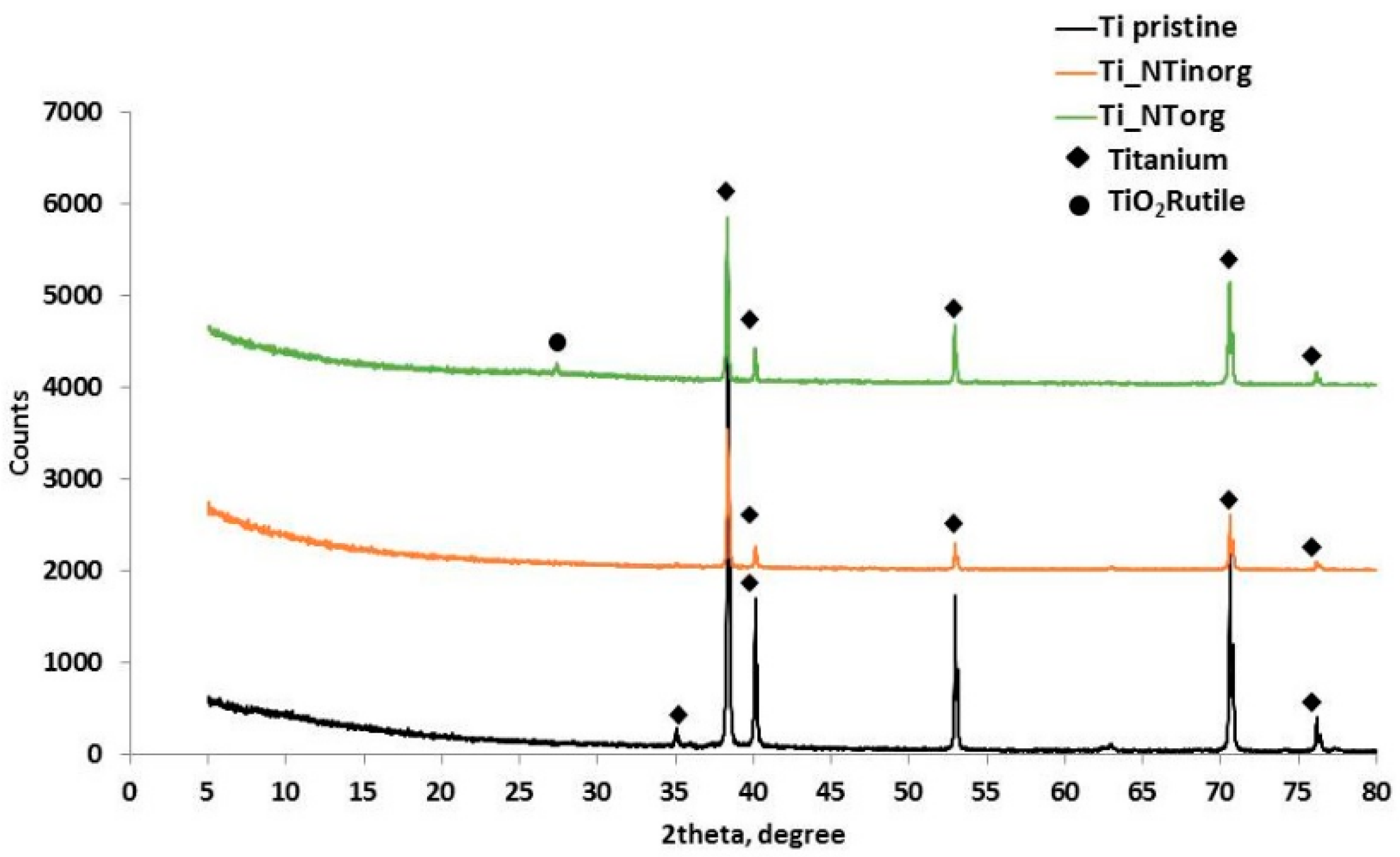
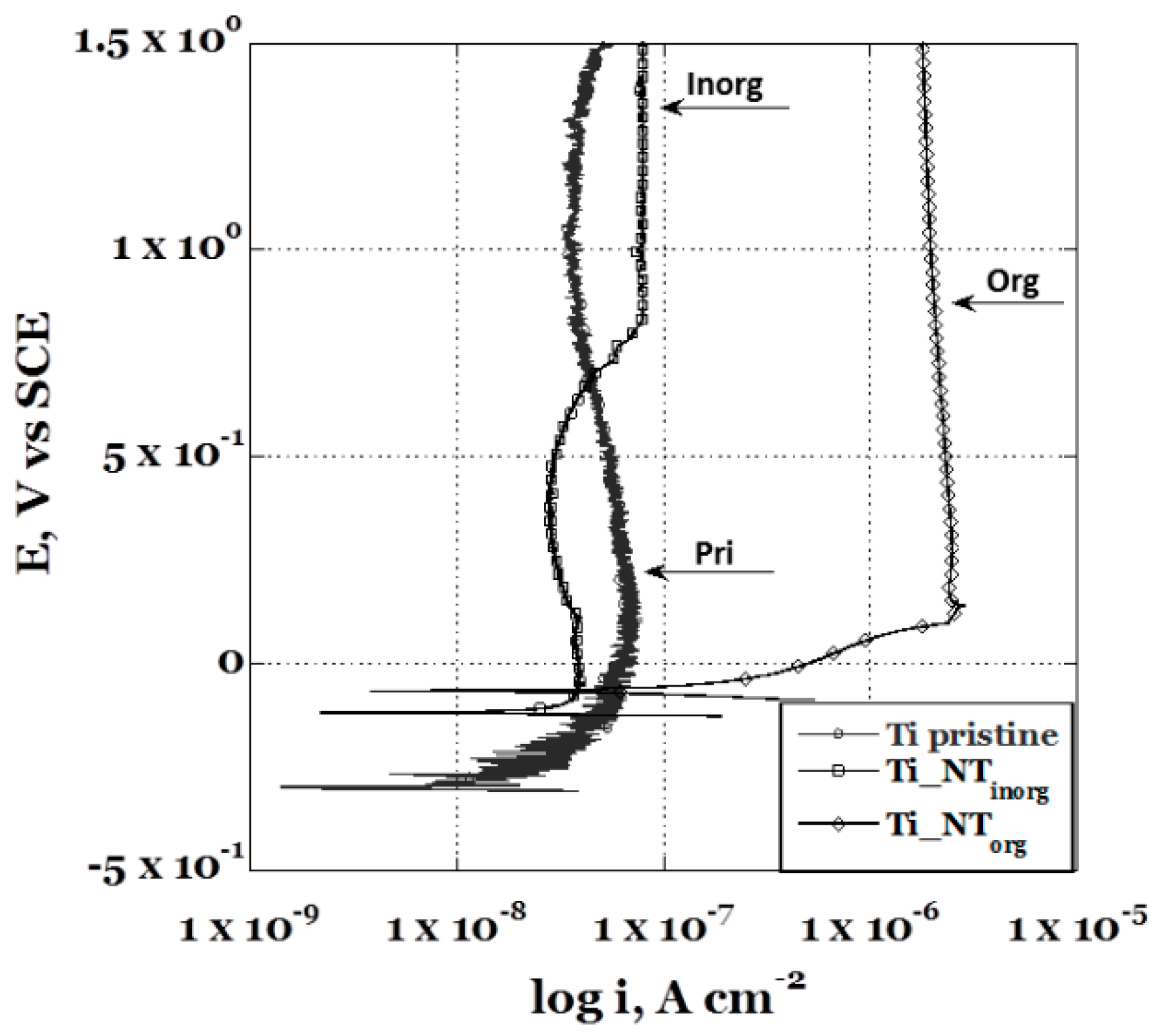
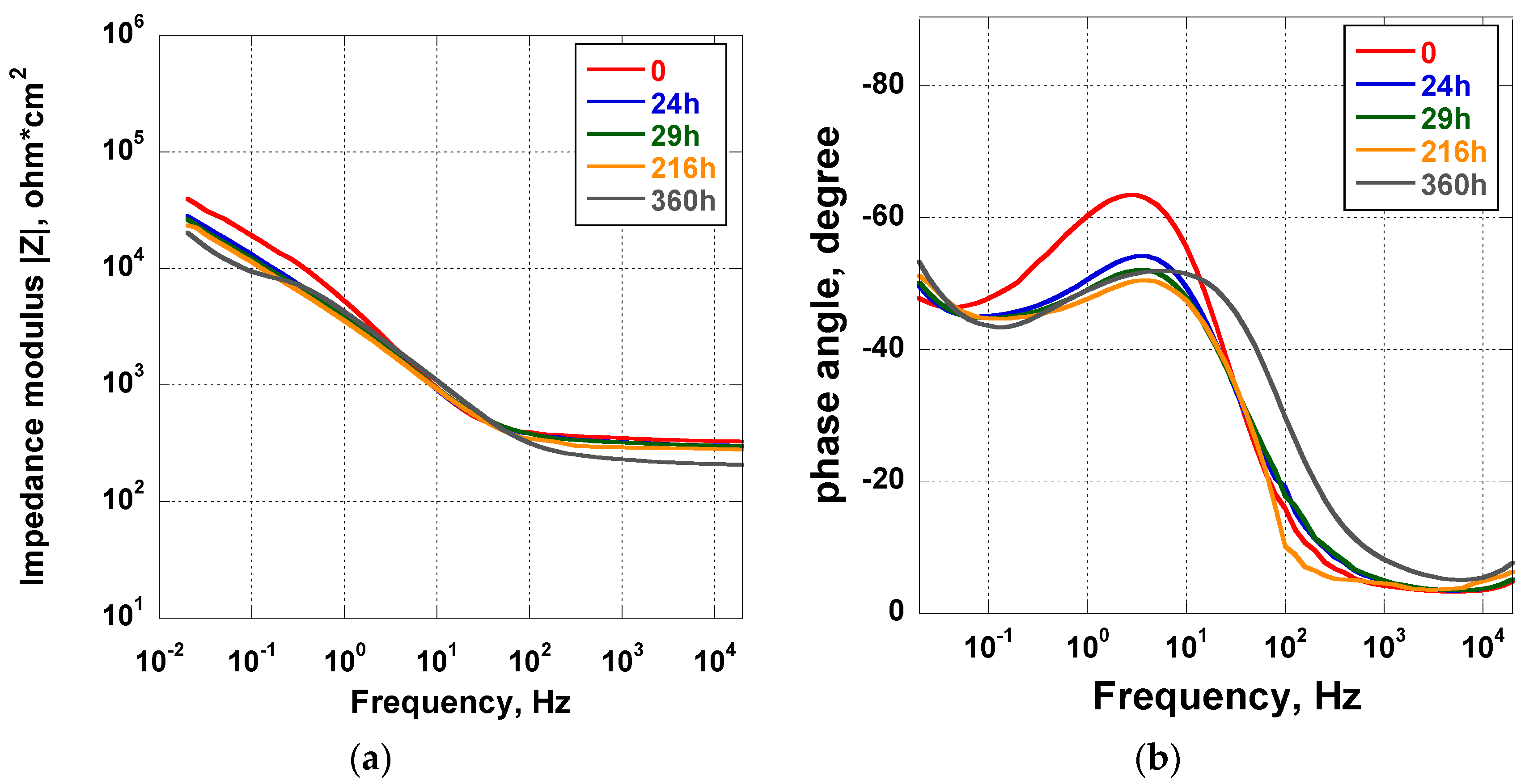

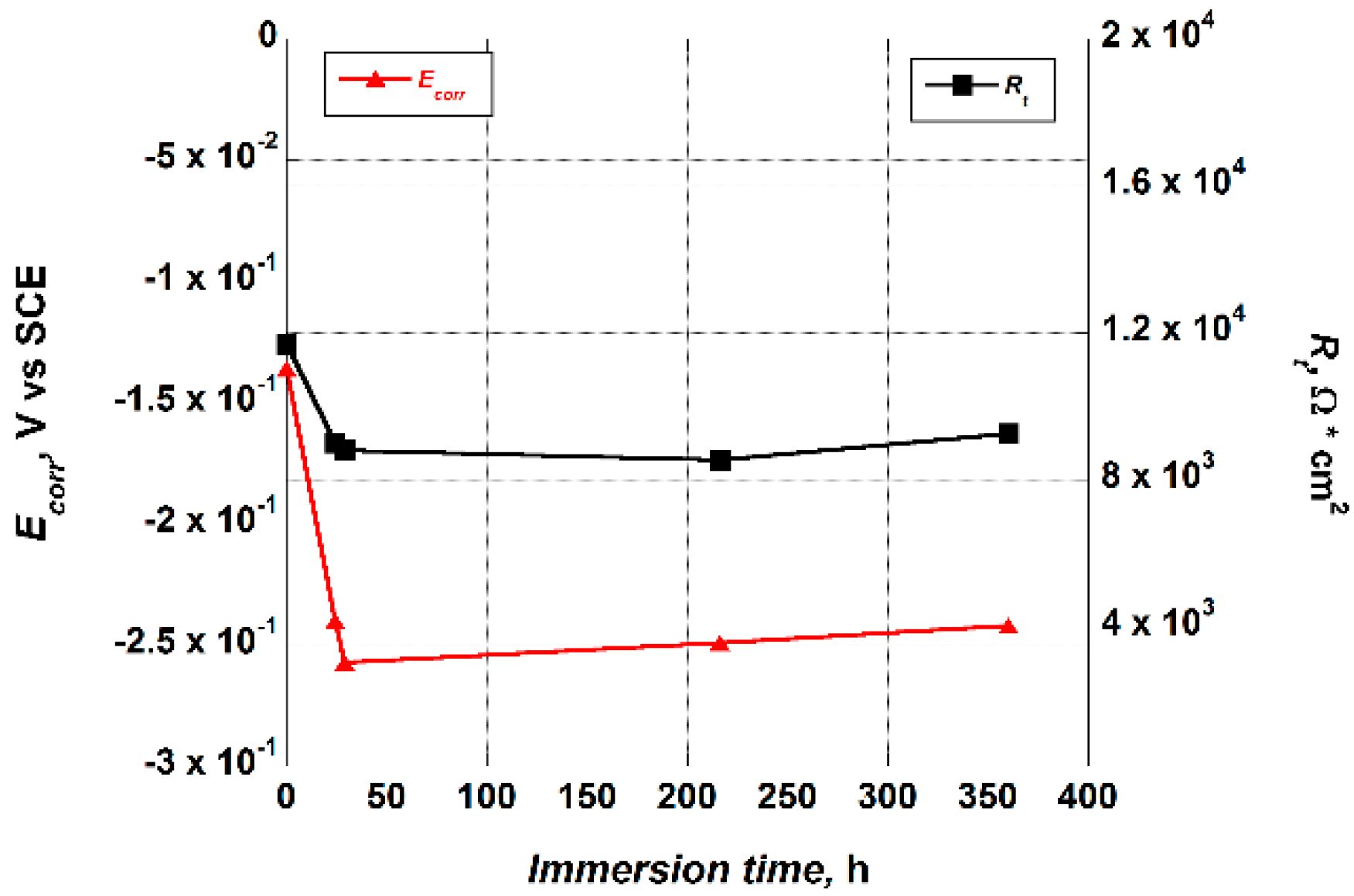
| Samples | Solution | Voltage (V) | Time (min) |
|---|---|---|---|
| Ti_NTinorg | H2O + 1 M H3PO4 + 0.5 wt % HF | 30 | 90 |
| Ti_NTorg | EG + 2.5 wt % NH4F + 12.5 wt % H2O | 30 | 1080 |
| Samples | Solution | Diameter (nm) | Length (µm) |
|---|---|---|---|
| Ti_NTinorg | H2O + 1 M H3PO4 + 0.5 wt % HF | 100 | 0.5 |
| Ti_NTorg | EG + 2.5 wt % NH4F + 12.5 wt % H2O | 70 | 8 |
| Immersion Time (h) | Ecorr (mV) | Rs (Ω∙cm2) | Rt (Ω∙cm2) | QPEt (F∙cm−2) | nt | Rb (Ω∙cm2) | QPEb (F∙cm−2) | nb | χ2 |
|---|---|---|---|---|---|---|---|---|---|
| 0 | −136 | 340.0 | 1.17 × 104 | 5.30 × 10−5 | 0.86 | 1.73 × 105 | 1.36 × 10−4 | 0.80 | 0.0056 |
| 24 | −240 | 306.6 | 9.01 × 103 | 8.40 × 10−5 | 0.74 | 1.49 × 106 | 2.00 × 10−4 | 0.75 | 0.0036 |
| 29 | −257 | 303.0 | 8.80 × 103 | 8.72 × 10−5 | 0.72 | 1.17 × 106 | 2.26 × 10−4 | 0.76 | 0.0027 |
| 216 | −249 | 261.0 | 8.55 × 103 | 9.35 × 10−5 | 0.70 | 1.35 × 106 | 2.49 × 10−4 | 0.77 | 0.0046 |
| 360 | −242 | 205.4 | 9.26 × 103 | 5.78 × 10−5 | 0.71 | 1.44 × 106 | 3.30 × 10−4 | 0.84 | 0.0098 |
| Immersion Time (h) | Ecorr (mV) | Rs (Ω∙cm2) | Rt (Ω∙cm2) | QPEt (F∙cm−2) | nt | Rb (Ω∙cm2) | QPEb (F∙cm−2) | nb | χ2 |
|---|---|---|---|---|---|---|---|---|---|
| 0 | −254 | 236.8 | 1.03 × 104 | 9.87 × 10−6 | 0.65 | 1.40 × 105 | 1.10 × 10−4 | 0.83 | 0.0031 |
| 24 | −176 | 310.1 | 2.84 × 104 | 2.13 × 10−5 | 0.73 | 2.17 × 106 | 8.02 × 10−4 | 0.90 | 0.0040 |
| 29 | −268 | 353.3 | 7.32 × 103 | 2.52 × 10−5 | 0.74 | 3.32 × 105 | 1.39 × 10−3 | 0.92 | 0.0019 |
| 216 | −234 | 336.4 | 1.92 × 104 | 2.14 × 10−5 | 0.84 | 1.88 × 105 | 1.17 × 10−4 | 0.92 | 0.0004 |
| 360 | −258 | 273.4 | 8.72 × 103 | 2.51 × 10−5 | 0.81 | 3.15 × 105 | 1.24 × 10−4 | 0.91 | 0.0009 |
© 2018 by the authors. Licensee MDPI, Basel, Switzerland. This article is an open access article distributed under the terms and conditions of the Creative Commons Attribution (CC BY) license (http://creativecommons.org/licenses/by/4.0/).
Share and Cite
Acquesta, A.; Carangelo, A.; Monetta, T. TiO2 Nanotubes on Ti Dental Implant. Part 3: Electrochemical Behavior in Hank’s Solution of Titania Nanotubes Formed in Ethylene Glycol. Metals 2018, 8, 489. https://doi.org/10.3390/met8070489
Acquesta A, Carangelo A, Monetta T. TiO2 Nanotubes on Ti Dental Implant. Part 3: Electrochemical Behavior in Hank’s Solution of Titania Nanotubes Formed in Ethylene Glycol. Metals. 2018; 8(7):489. https://doi.org/10.3390/met8070489
Chicago/Turabian StyleAcquesta, Annalisa, Anna Carangelo, and Tullio Monetta. 2018. "TiO2 Nanotubes on Ti Dental Implant. Part 3: Electrochemical Behavior in Hank’s Solution of Titania Nanotubes Formed in Ethylene Glycol" Metals 8, no. 7: 489. https://doi.org/10.3390/met8070489
APA StyleAcquesta, A., Carangelo, A., & Monetta, T. (2018). TiO2 Nanotubes on Ti Dental Implant. Part 3: Electrochemical Behavior in Hank’s Solution of Titania Nanotubes Formed in Ethylene Glycol. Metals, 8(7), 489. https://doi.org/10.3390/met8070489







